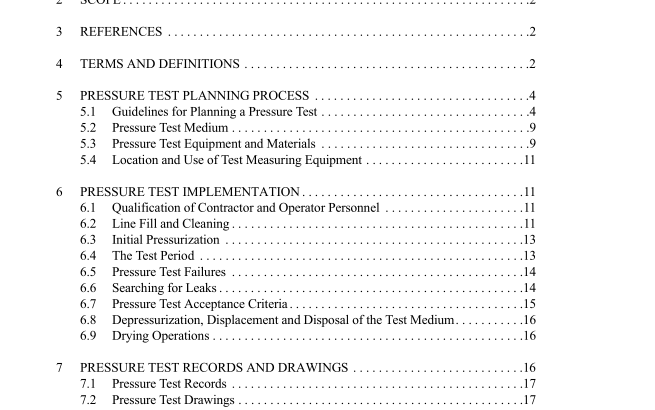API RP 1110:2007 pdf free download.Pressure Testing of Steel Pipelines for the Transportation of Gas, Petroleum Gas, Hazardous Liquids, Highly Volatile Liquids or Carbon Dioxide
4.14 feature: Any physical object detected by an in-line inspection device. Features may be anomalies, components, nearby metallic objects, or some other item.
4.15 freeze plug: A pipeline isolation point created by freezing hydrostatic test water inside the pipeline by the application of liquid nitrogen to the outer surface of the pipe. Normally used to separate a test section into smaller test segments in order to identify leaks more readily or used to establish a test boundary.
4.16 gas: Natural gas, flammable gas or gas which is toxic or corrosive.
4.17 gouge: Elongated grooves or cavities caused by mechanical removal of metal.
4.18 hazardous liquid: Petroleum, petroleum products or anhydrous ammonia.
4.19 highly volatile liquid: A hazardous liquid which forms a vapor cloud when released to the atmosphere and has a vapor pressure exceeding 40 psia (276 kPa) at 100ºF (37.8ºC).
4.20 inspection: The use of a nondestructive testing technique.
4.21 leak test: A pipeline test designed to determine the presence or absence of leaks in a pipeline system. A leak test can be used alone or in addition to a spike pressure test and/or a strength pressure test as required by the pressure testing plan.
4.22 Nondestructive Testing (NDT): A process that involves the inspection, testing or evaluation of materials, components and assemblies for materials’ discontinuities, properties and machine problems without further impairing or destroying the part’s serviceability.
4.23 operating pressure: The actual steady-state pressure at a discrete point within a pipeline system at a specific time.
4.24 operating pressure limit: A generic term used to describe the upper end of the operating pressure range of a pipeline.
In international codes and standards, it is often referred to as the Maximum Steady State Operating Pressure (see ASME B31.4—2002, Section 400.2) or Maximum Allowable Operating Pressure (see ASME B31.8—2003, Section 805.214).
4.25 operator: A person or organization that operates pipeline facilities.
4.26 petroleum: Crude oil, condensate, natural gasoline, natural gas liquids, and liquefied petroleum gas.
4.27 petroleum gas: Propane, propylene, butane (normal butane or isobutanes), and butylenes (including isomers), or mixtures composed predominantly of these gases, having a vapor pressure not exceeding 208 psig (1,434 kPa) at 100°F (37.8°C).
4.28 petroleum products: Flammable, toxic, or corrosive products obtained from distilling and processing of crude oil, unfinished oils, natural gas liquids, blend stocks and other miscellaneous hydrocarbon compounds.
4.29 pipeline: A continuous part of a pipeline facility used to transport a gas, petroleum gas, hazardous liquids, highly volatile liquids or carbon dioxide. Includes pipe, valves, and other appurtenances attached to pipe.
4.30 pipeline system: All portions of the physical facilities through which gas, petroleum gas, hazardous liquids, highly volatile liquids or carbon dioxide moves during transportation. This includes pipe, valves, and other appurtenances attached to the pipe, compressor units, pumping units, metering stations, regulator stations, delivery stations, breakout tanks, holders, and other fabricated assemblies.
4.31 pressure reversal: A phenomenon whereby a pipeline segments fails at progressively lower test pressures during subsequent pressure tests.
4.32 qualification (personnel): The process of demonstrating skill and knowledge, along with documented training and experience required for personnel to properly perform the duties of a specific job.
4.33 seam: The longitudinal or spiral weld in fabricated line pipe.
4.34 service provider: Any organization or individual providing services to operators.
4.35 shall: The term “shall” is used to indicate those practices that are mandatory.
4.36 should: The terms “should” or “it is recommended” are used to indicate that a provision is not mandatory but recommended as good practice.
4.37 Specified Minimum Yield Strength (SMYS): The minimum yield strength prescribed by the specification under which pipe and fittings are purchased from the manufacturer.
4.38 spike pressure test: A pressure test of short duration (typically less than 1 hour) and high amplitude (test pressure ratio typically greater than 1.25).
4.39 strength pressure test: A pressure test designed to establish the operating pressure limit of a pipeline as required by code or regulation.
4.40 stress: Tensile, shear or compressive force per unit area.
4.41 Stress Corrosion Cracking (SCC): A form of cracking of a material produced by the combined action of tensile stress (residual or applied), a corrosive environment, and material that is susceptible to SCC.
4.42 test medium: The fluid or gas used to conduct a pressure test.
4.43 test pressure ratio: The test pressure divided by the operating pressure limit of a pipeline system.API RP 1110 pdf download.API RP 1110:2007 pdf free download
